Donald Robertson • • 7 min read
The 5 Most Captivating Modern Books on Stoicism

“Sometimes even to live is an act of courage.”
― Lucius Annaeus Seneca
At the beginning of his personal record of philosophical reflections, The Meditations, the Stoic Roman emperor Marcus Aurelius thanks the gods that once he became interested in philosophy, as a young man, he did not merely “sit down to pore over books” (1.17). Stoicism is a philosophy of action. Elsewhere, therefore, he tells himself:
Put away your books, distract yourself with them no longer, that is not permissible; but rather, as though you were now on the verge of death, despise the flesh—just blood and bones and a mesh of interwoven nerves, veins, and arteries. […] Look at the matter in this way: you are an old man, no longer allow this [ruling, conscious] part of you to act as a slave, no longer allow it to be tugged this way and that, like a puppet, by each unsociable impulse, no longer allow it to be discontented with its present lot or flinch from what will fall to it in the future. (Meditations, 2.2)
However, Marcus also said that one of the key moments of his life occurred when his beloved Stoic tutor, Junius Rusticus, presented him with a copy of notes from the lectures of Epictetus, which belonged to his own personal library. Ancient students of Stoicism were warned not to read widely merely for the sake of intellectual curiosity, without putting any of what they learned into practice. Instead, they were to focus on books that contained genuine practical wisdom, study them closely, and apply the teachings they learned in daily life.
In another article, I provided details of the three most important Stoicism books written by the ancient Stoics themselves. These are classics, like the Discourses of Epictetus or Meditations of Marcus Aurelius, which are worth reading over and over again. However, Stoicism has been going through a resurgence in popularity since the 1950s and there are also many modern Stoicism books that deserve to be read by anyone interested in philosophy as a way of life. In this article, I’m going to introduce you to some of the most popular texts that have a practical self-help focus, rather than dealing with academic ones, which are of a more historical or theoretical orientation.
So let’s start by looking at three of my favourite modern books on Stoicism…
5 Best Stoicism Books of Modern Era:
The Daily Stoic: 366 Meditations on Wisdom, Perseverance, and the Art of Living (2016) by Ryan Holiday and Stephen Hanselman
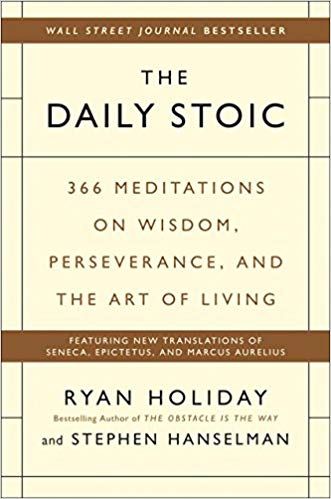
I found the new translations of the ancient texts very valuable, and especially the glossary of Stoic technical terms at the back of the book. The commentaries were also very readable and worthwhile, and include a wide range of literary and philosophical references. These undoubtedly help to make the Stoic texts appear more relevant and accessible to modern readers. The passages included are mainly from the philosophical writings of the three most famous Stoics: Seneca, Epictetus (via his student Arrian), and Marcus Aurelius. However, there are also several gems from the Stoic sayings of Zeno included in Diogenes Laertius, and from the often-overlooked plays of Seneca.
Most people will find this very-readable collection of Stoic sayings to be a great introduction to the philosophy. It stands in a long tradition: anthologies of philosophical sayings were common in the ancient world. Indeed, many passages from the early Greek Stoics only survive today thanks to compilations of philosophical sayings such as the Anthology of Stobaeus and Diogenes Laertius’ Lives and Opinions of Eminent Philosophers.
The Practicing Stoic: A Philosophical User’s Manual (2018) by Ward Farnsworth
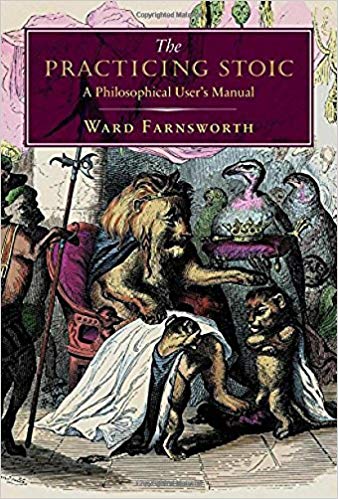
Farnsworth concludes with a particularly valuable chapter called ‘Stoicism and its critics’ which cites important objections made against Stoicism by various authors. These are addressed by Farnsworth who thereby dispels several common misconceptions about Stoicism such as the idea that Stoics are cold-hearted, unemotional, or lacking compassion.
I particularly like his point that the goal of Stoicism resembles the sort of emotional response we’d expect someone to have to distressing events if they could have lived much longer and experienced them enough times to become used to them. He explains the Stoic attitude to consoling grieving friends as follows…
Your attitude might resemble that of a doctor – a very good one let’s say – who has had a long career of working with dying patients and their families. In the best doctor of that sort we would find kindness, warmth, and compassion. There would be feeling. But emotion [passion] would be unlikely. You would sympathize but you would not go through mourning of your own. You would have seen it all too many times for that.
Those of you who have read some Stoicism books already will definitely find this a fresh take on things and newcomers to the subject will also enjoy it and find it very accessible.
How to be a Stoic: Using Ancient Philosophy to Live a Modern Life (2018) by Massimo Pigliucci
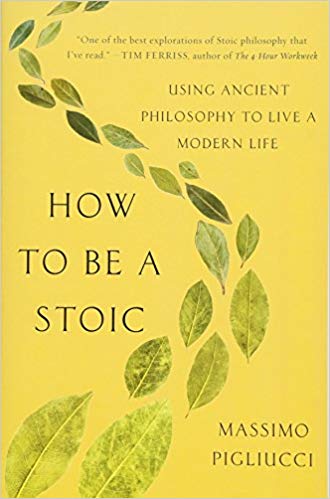
The main part is divided into three sections. These deal respectively with training in mastering our desires and emotions, organizing our actions around a coherent moral goal, and learning to withhold our assent from initial misleading impressions. Pigliucci concludes by describing a list of a dozen Stoic exercises:
- Examine your impressions, checking whether they place too much value on external things outside your direct control.
- Remind yourself of the impermanence of things.
- The reserve clause, which means adding the caveat “fate permitting” to every planned action.
- How can I use virtue here and now?
- Pause and take a deep breath, waiting for strong emotions to abate naturally rather than acting rashly when we’re upset.
- Other-ize, getting beyond personalization by considering how we’d feel about our misfortunes if they befell another person.
- Speak little and well – the Stoics were known for speaking “laconically”, like Spartans.
- Choose your company well.
- Respond to insults with humour.
- Don’t speak too much about yourself.
- Speak without judging, just stick to the facts and remain objective.
- Reflect on your day, by reviewing events each evening in a constructive and dispassionate manner, looking for areas in which you can improve.
Indeed, some people might actually benefit from skipping to the end and reading this concluding section of the book first.
I’ve also written several Stoicism books myself. The two I’d recommend to beginners are…
Stoicism and the Art of Happiness: Second Edition (2018)
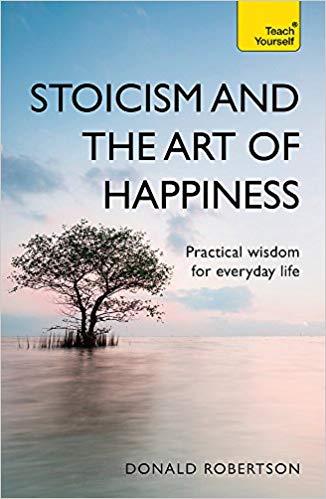
was first published in 2013 as part of Hodder’s popular Teach Yourself series, which follows a structured self-help format with bullet points, questions, case studies, reminder boxes, etc. It’s a designed to teach people how to apply Stoic concepts and techniques in daily life by drawing comparisons with aspects of modern cognitive-behavioural therapy (CBT).
It opens with one of my favourite quotes from Seneca:
Why, then, do you wonder that good men are shaken in order that they may grow strong? No tree becomes rooted and sturdy unless many a wind assails it. For by its very tossing it tightens its grip and plants its roots more securely; the fragile trees are those that have grown in a sunny valley. It is, therefore, to the advantage even of good men, to the end that they may be unafraid, to live constantly amidst alarms and to bear with patience the happenings which are ills to him only who ill supports them. (On Providence)
The book begins with a chapter on “the way of the Stoic”, explaining what’s meant by their fundamental slogan “Living in agreement with Nature”. It goes on to discuss Stoic ethics, the therapy of the passions, discipline of desire, Stoic teachings on love and friendship, action in Stoicism, the premeditation of adversity, discipline of judgement and Stoic mindfulness, and concludes with a chapter on Stoic cosmology and the contemplative practice known as the View from Above, which entails picturing the world as if seen from high overhead, like the gods looking down from Olympus . A revised second edition was published in 2018 which contains hundreds of small changes as well as a whole new chapter on the Stoic contemplation of death.
How to Think Like a Roman Emperor: The Stoic Philosophy of Marcus Aurelius (2019)
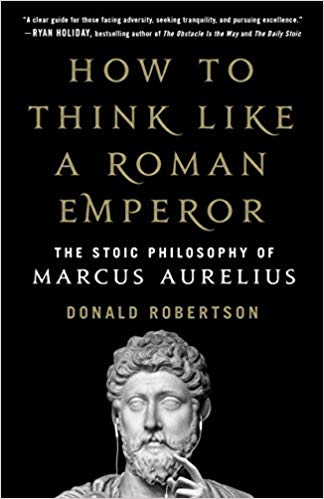
The Stoics believed that we learn far more from role models than we do from lectures. I realized that one of the best ways to introduce people to Stoic ideas is through stories about real individuals who actually lived according to the philosophy.
The historical Stoic about whom we know the most is actually Marcus Aurelius. That’s because he was a Roman emperor and so we have several surviving Roman histories describing his reign and his character as a ruler. How to Think Like a Roman Emperor weaves together the outer story of his life as emperor, based on the Roman histories, with the inner story of his philosophical and psychological journey, based on his own words in The Meditations.
In fact, by approaching the subject in this way, and putting a human face on Stoicism, we avoid some of the most widespread misconceptions about the subject. For instance, some people incorrectly assume that the Stoics’ emphasis on accepting fate should make them passive doormats. However, from the life of Marcus Aurelius, as well as his philosophical reflections, we can see that Stoics meant we should reconcile emotional acceptance with a commitment to vigorous and determined action in the service of wisdom and justice.
When the Marcomanni and their northern allies invaded Rome, Marcus didn’t sit on his hands. He donned the military cape and boots and rode forth from Rome to take command of the largest army ever assembled on a Roman frontier. Likewise, some people believe that Stoics are cold and unemotional. Marcus, though, was a loving husband and father, renowned for his kindness and forgiveness toward others. At the start of The Meditations he actually describes the Stoic ideal as being exemplified by someone free from irrational passions and yet full of love and natural affection.
Additional Reading
Each of the best books on Stoicism above provides a useful modern introduction to Stoicism, which can complement your reading of the classics. A few other titles worth mentioning are: Unshakeable Freedom by Chuck Chakrapani, More Than Happiness by Antonia Macaro, The Obstacle is the Way by Ryan Holiday, A Guide to the Good Life by William Irvine, Stoicism, A Very Short Introduction by Brad Inwood, and Thoughts of a Philosophical Fighter Pilot by James Stockdale.
Also, Antifragile by Nassim Taleb, Backbone by Karen Duffy, and Happy by Derren Brown contain interesting chapters about Stoic philosophy. These Stoicism books explicitly discuss ancient Stoic philosophy and its relevance to modern living.


![Seneca’s Groundless Fears: 11 Stoic Principles for Overcoming Panic [Video]](/content/images/size/w600/wp-content/uploads/2020/04/seneca.png)







